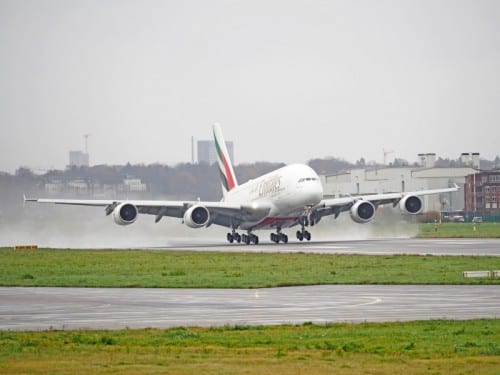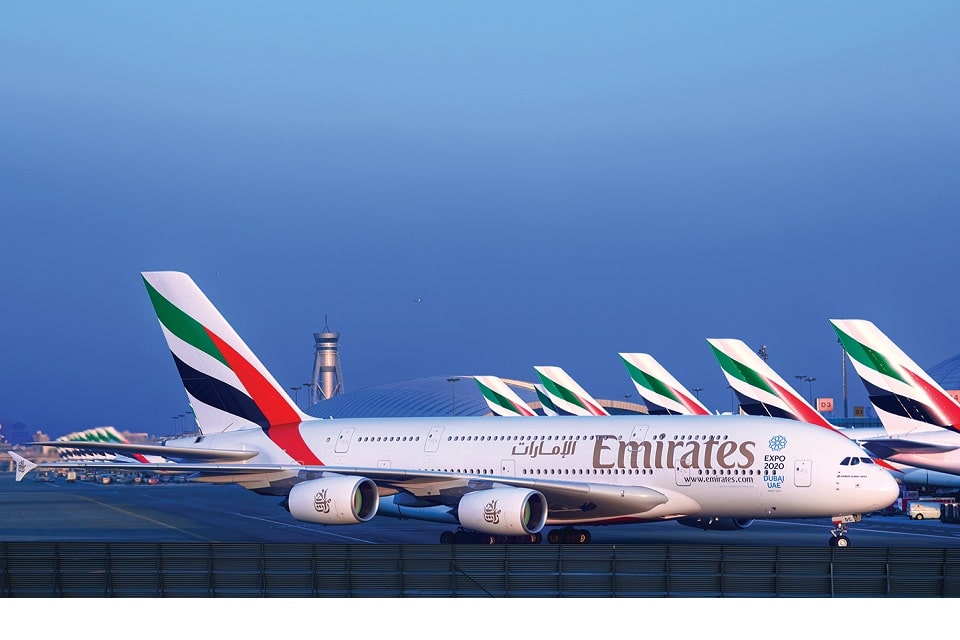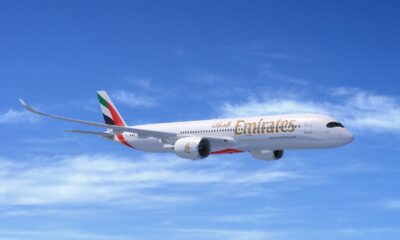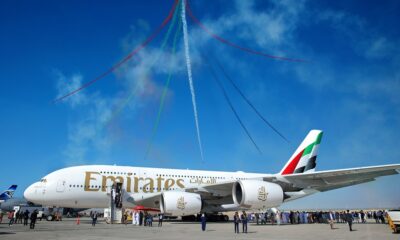Aviation
Emirates will offer A380 service on flights to Bengaluru for the first time
-Emirates to be the first airline to operate the iconic A380 to Bengaluru’s Kempegowda International Airport
-Flagship A380 service to be introduced as a daily service and allows customers travelling to and from the South Indian city to enjoy the much-loved signature experience
-Bengaluru to join Emirates’ network of over 30 destinations served by the double-decker aircraft

Dubai, UAE – 16 August 2022: Emirates has announced that its flagship A380 service will be introduced to Bengaluru for the first time on October 30 to serve customers on the busy route. Emirates also becomes the first airline to operate scheduled passenger services at Bengaluru’s Kempegowda International Airport using the A380, the world’s largest commercial aircraft in service.
Bangalore is hosting the A380 operations for the first time. At Bengaluru’s Kempegowda International Airport, Emirates also becomes the first airline to run regularly scheduled passenger services using the A380, the largest commercial aircraft in operation, according to a press statement.
The aircraft upgrade will allow customers travelling to and from the South Indian city to enjoy its signature services across a broader network. Bengaluru will be the second city in India to be served by the iconic Emirates A380 aircraft, with customers enjoying the signature experience on the Dubai – Mumbai route since 2014.
The daily A380 flights will operate as EK568/569 with an aircraft in a three-class configuration, offering seats in Economy Class, in addition to premium cabins, in Business Class and First Class. The deployment of the double-decker aircraft will complement its existing services, EK564/565 and EK566/567, each also operating on a daily basis with modern wide-body Boeing 777 aircraft. Flights EK564/565 will operate using a mix of Boeing 777-200LR and Boeing 777-300ER aircraft while EK566/567 will offer seats in First Class, Business Class and Economy Class aboard a Boeing 777-300ER aircraft.
— Jetline Marvel (@jetline_marvel) August 17, 2022
Top 5 best leadership traits that set Emirates besides other airlines.(Opens in a new browser tab)
from 30 October, Emirates’ three daily flights to/ from Bengaluru will operate as follows:
Dates
Flight
Departure
Arrival
Aircraft type
From 30 October
EK564 (DXB/BLR)
03:40
08:50
Boeing 777
EK565 (BLR/DXB)
10:25
13:00
From 30 October
EK566 (DXB/BLR)
13:35
18:35
Boeing 777
EK567 (BLR/DXB)
20:20
23:00
From 30 October
EK568 (DXB/BLR)
21:25
02:30 (next day)
A380
From 31 October
EK569 (BLR/DXB)
04:30
07:10
Emirates has been deploying its flagship A380 aircraft to an expanded list of destinations to meet high customer demand on routes popular amongst global travellers, boosting capacity on a single flight by up to 45 percent more than the Boeing 777 aircraft. Destinations served by the Emirates A380 aircraft currently stand at over 30 airports across six continents for August, with a total of over 130 destinations in the airline’s worldwide network.
The Emirates A380 experience has remained a long-time favourite amongst travel enthusiasts, loved for its extra legroom and comfort and the industry’s largest screens for customers across all cabins to enjoy the airline’s extensive selection of content on its award-winning in-flight entertainment system, ice. Customers travelling in premium cabins continue to return again and again when making travel plans, for its signature features such as the popular Onboard Lounge and fully flat seats in Business Class, as well as private suites and Shower Spas in First Class.
Read more :
10 effective leadership traits of Emirates that contributed to the airline’s steady growing market

Aviation
South Korea Introduces Cutting-Edge MRO Center for F-35 and IAI

South Korea is set to make waves in the aerospace industry with the establishment of a cutting-edge Maintenance, Repair, and Overhaul (MRO) hub for F-35 fighter jets and IAI (Israel Aerospace Industries) aircraft.
Central to this initiative is the specialization in converting Boeing 777-ERSF, colloquially known as the “Big Twin,” from passenger to freighter configurations. Under the terms of the agreement, IAI will spearhead the conversion of six B777-300ER and B777-200LR aircraft annually, commencing in 2024. This strategic move is in response to the anticipated surge in demand for wide-body freighter aircraft capable of long-haul flights.
Furthermore, South Korea’s forward-looking vision extends beyond aircraft conversion, with plans to establish a Lockheed Martin F-35 maintenance, repair, and overhaul depot at Cheongju Air Base by 2027. This strategic move not only enhances the operational readiness of South Korea’s air force but also positions the nation as a regional hub for F-35 maintenance expertise.
In preparation for this expansion, thirty Republic of Korea Air Force (ROKAF) engineers and technicians are slated to undergo intensive maintenance training in the United States in 2025, a testament to South Korea’s commitment to fostering local expertise and talent.
IAI’s visionary approach to certification and collaboration underscores the potential for transformative change. With plans for the 777-300ERSF certification process set to unfold in Israel, followed by the rigorous scrutiny of regulatory agencies such as the US Federal Aviation Administration (FAA), the stage is set for the ‘Big Twin’ to soar to new heights of success.
In partnership with esteemed entities like STK and Incheon International Airport Corporation, this collaboration promises to unleash a wave of benefits, amplifying the resilience and competitiveness of the Korean aviation sector while catalyzing job creation and economic prosperity.
Aviation
Lockheed Martin Expresses Interest in Joining AMCA Project

Lockheed Martin, a leading global aerospace and defense company, is demonstrating its dedication to strengthening collaborations with India’s research, industry, and academic sectors. With its rich experience in the aerospace industry and renowned for building some of the world’s most advanced jets, Lockheed Martin is now exploring opportunities to contribute to India’s aerospace sector, potentially providing a significant boost to aerospace technology in the country.
Randy Howard, Vice President of Global Pursuits at Lockheed Martin Aeronautics, recently underscored their interest in exploring “advanced transfer of technology opportunities” with Indian partners, signaling a proactive approach towards fostering technological exchange and advancement in the aerospace domain.
India has been at the forefront of fighter jet development since the 1970s, having produced its own cost-effective fighter jets and combat helicopters, while continually upgrading to maintain competitiveness on a global scale.
Lockheed Martin stands as a dominant force in the aircraft industry, renowned for developing cutting-edge planes like the F35 and F22, some of the most advanced fighter jets globally. They’ve also contributed to projects like the South Korean KF21 aircraft for defense purposes through collaborations.
Now, Lockheed Martin has set its sights on India’s defense sector manufacturing processes, expressing interest in partnering with India on its most anticipated project, the Advanced Medium Combat Aircraft (AMCA), likely to be a 5th generation fighter jet for the Indian military.
Their proposed collaboration could involve a spectrum of advanced technologies, including the Auto Ground Collision Avoidance System (Auto GCAS), a life-saving technology that intervenes to prevent ground collisions, thus significantly enhancing flight safety for Indian pilots.
Lockheed Martin is extending its expertise to design and develop an indigenous cockpit for the F-21 fighter jets, which India is procuring. This collaboration with Tata also includes the development of fighter jet wings. Established in 2023, this partnership adopts a “Ground Floor Design” strategy aimed at equipping India with an in-depth comprehension of 5th-generation cockpit technology and Man-Machine Interface (MMI) systems.
As India’s Fighter jet program advances with finalized aircraft frame and engine prototypes, Lockheed Martin has expressed interest in joining the project. They see a groundbreaking opportunity in cooperative 5th Generation Fighter Development, potentially expediting the AMCA program’s progress through technology and expertise sharing.
Furthermore, Lockheed Martin is keen on collaborating on large-wing, jet-powered UAV platforms, which could enhance India’s unmanned aerial capabilities.
While discussions are ongoing, and specific collaboration details await finalization, this initiative represents a potentially transformative stride in India’s aerospace self-reliance journey and Lockheed Martin’s strategic engagement with the Indian market.
Aviation
Can Airline Seat Cushions Be Used As Life Jackets?

In the event of an aircraft ditching into water, there’s a common question: Can aircraft seats serve as an alternative to life jackets for flotation? The answer lies in understanding their respective functions.
While seat cushions can provide some buoyancy in water, they are not intended nor certified to function as life jackets. Their primary purpose is to offer cushioning for passengers during flight. On the other hand, life jackets are meticulously engineered to keep individuals afloat in water, equipped with buoyancy materials, secure straps, and reflective elements for visibility. They offer numerous advantages over mere cushions.
While a seat cushion might offer temporary assistance in staying afloat, it’s not a dependable substitute for a proper life jacket during an emergency. It’s crucial to utilize approved safety equipment when near bodies of water. A life jacket, designed to keep a person buoyant for extended periods, offers the rigidity needed for prolonged flotation and allows for easy movement of the arms to navigate effectively.
What fabric is used in aircraft seats?
Seats are meticulously designed to fulfill multiple purposes, ensuring passenger comfort, safety, and protection from unforeseen circumstances like fires and accidents. A typical design incorporates an aluminum frame with blocks of polyurethane foam affixed to it. Additionally, a layer of fire-resistant fabric, such as Kevlar or Nomex, is often applied over this framework, topped with a layer of cloth or leather.
Leather seats, while luxurious, are more expensive compared to traditional cloth seats. The majority of fabrics used in seat upholstery contain at least 90% wool fiber, with the remainder typically consisting of polyamide (nylon). Wool stands out as the primary fiber chosen for commercial airline seating fabric due to its desirable properties and suitability for such applications.
What is the lightest economy seat?
In recent times, airlines have been downsizing seat dimensions to accommodate more passengers, resulting in reduced cushion length and leg space. This contrasts with earlier times when airlines offered more generously cushioned seats and ample amenities.
According to Recaro Seats Company, their SL3710 model represents the lightest economy class seat available, weighing in at a mere 8 kg (17.6 lb.), setting a new standard in aircraft seating.
For individuals weighing more than 350 pounds, fitting into a standard economy-class seat can be a challenge due to the narrower dimensions. Economy seats, also referred to as “coach,” “standard,” or “main cabin” seats, typically range from about 40 to 48 centimeters in width, further emphasizing the need for more accommodating seating options.




























